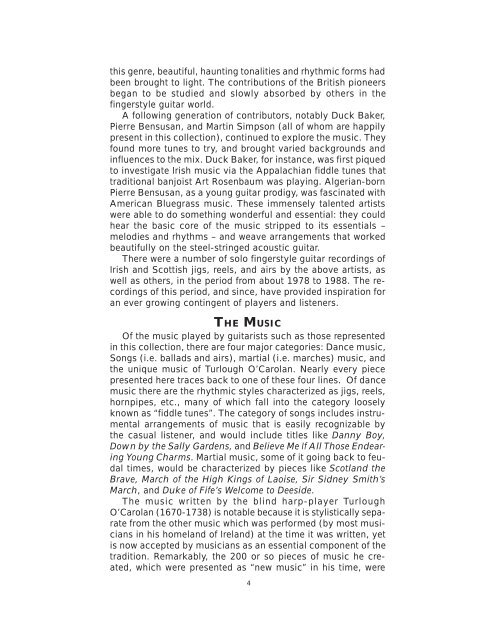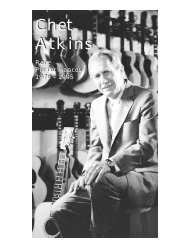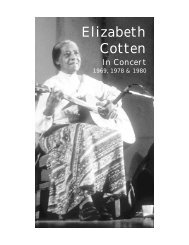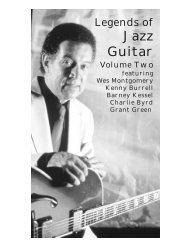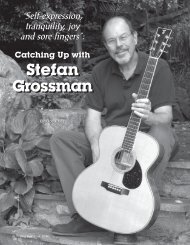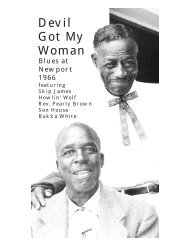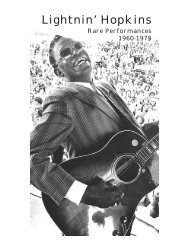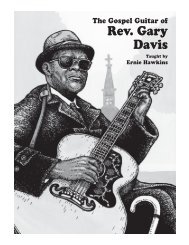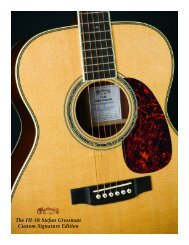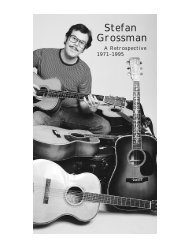Download PDF Booklet - Stefan Grossman's Guitar Workshop
Download PDF Booklet - Stefan Grossman's Guitar Workshop
Download PDF Booklet - Stefan Grossman's Guitar Workshop
Create successful ePaper yourself
Turn your PDF publications into a flip-book with our unique Google optimized e-Paper software.
this genre, beautiful, haunting tonalities and rhythmic forms had<br />
been brought to light. The contributions of the British pioneers<br />
began to be studied and slowly absorbed by others in the<br />
fingerstyle guitar world.<br />
A following generation of contributors, notably Duck Baker,<br />
Pierre Bensusan, and Martin Simpson (all of whom are happily<br />
present in this collection), continued to explore the music. They<br />
found more tunes to try, and brought varied backgrounds and<br />
influences to the mix. Duck Baker, for instance, was first piqued<br />
to investigate Irish music via the Appalachian fiddle tunes that<br />
traditional banjoist Art Rosenbaum was playing. Algerian-born<br />
Pierre Bensusan, as a young guitar prodigy, was fascinated with<br />
American Bluegrass music. These immensely talented artists<br />
were able to do something wonderful and essential: they could<br />
hear the basic core of the music stripped to its essentials –<br />
melodies and rhythms – and weave arrangements that worked<br />
beautifully on the steel-stringed acoustic guitar.<br />
There were a number of solo fingerstyle guitar recordings of<br />
Irish and Scottish jigs, reels, and airs by the above artists, as<br />
well as others, in the period from about 1978 to 1988. The recordings<br />
of this period, and since, have provided inspiration for<br />
an ever growing contingent of players and listeners.<br />
THE MUSIC<br />
Of the music played by guitarists such as those represented<br />
in this collection, there are four major categories: Dance music,<br />
Songs (i.e. ballads and airs), martial (i.e. marches) music, and<br />
the unique music of Turlough O’Carolan. Nearly every piece<br />
presented here traces back to one of these four lines. Of dance<br />
music there are the rhythmic styles characterized as jigs, reels,<br />
hornpipes, etc., many of which fall into the category loosely<br />
known as “fiddle tunes”. The category of songs includes instrumental<br />
arrangements of music that is easily recognizable by<br />
the casual listener, and would include titles like Danny Boy,<br />
Down by the Sally Gardens, and Believe Me If All Those Endearing<br />
Young Charms. Martial music, some of it going back to feudal<br />
times, would be characterized by pieces like Scotland the<br />
Brave, March of the High Kings of Laoise, Sir Sidney Smith’s<br />
March, and Duke of Fife’s Welcome to Deeside.<br />
The music written by the blind harp-player Turlough<br />
O’Carolan (1670-1738) is notable because it is stylistically separate<br />
from the other music which was performed (by most musicians<br />
in his homeland of Ireland) at the time it was written, yet<br />
is now accepted by musicians as an essential component of the<br />
tradition. Remarkably, the 200 or so pieces of music he created,<br />
which were presented as “new music” in his time, were<br />
4


